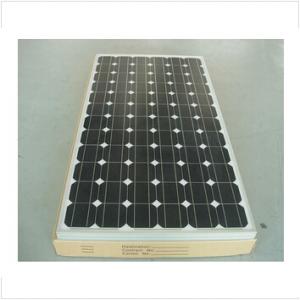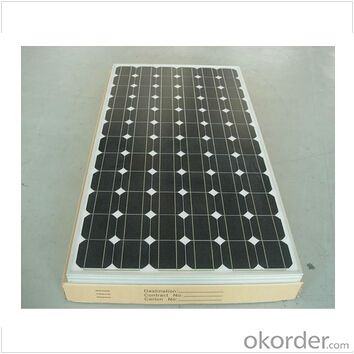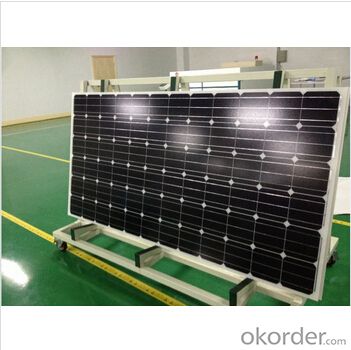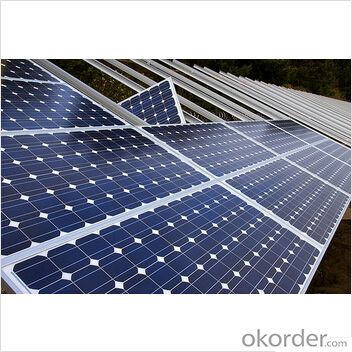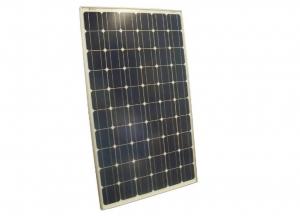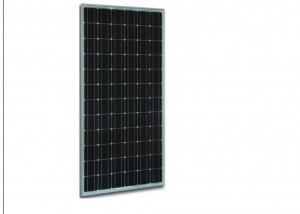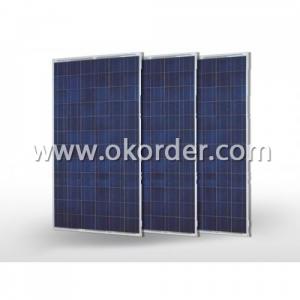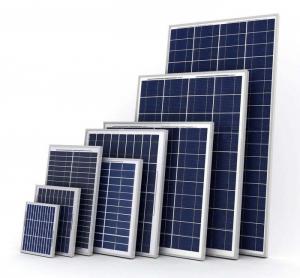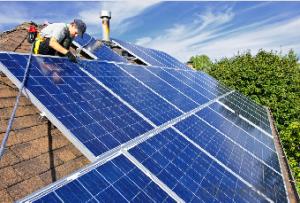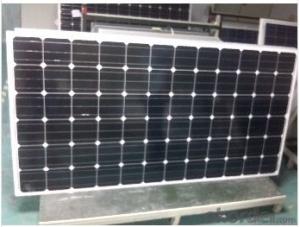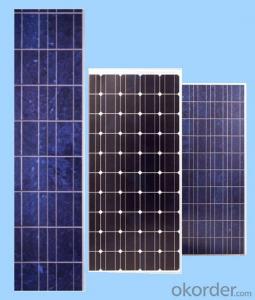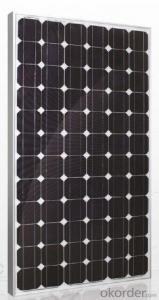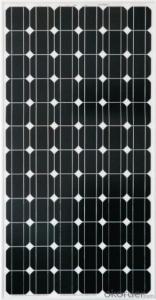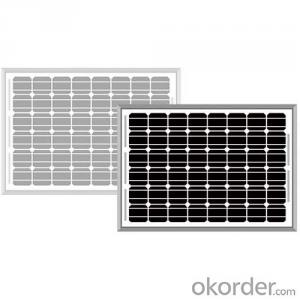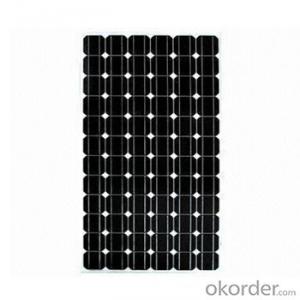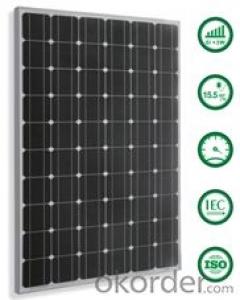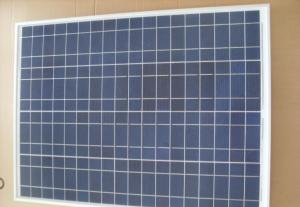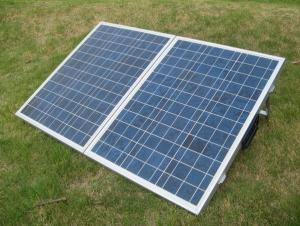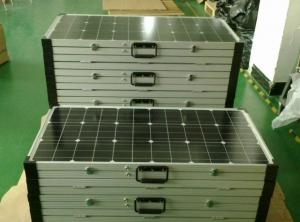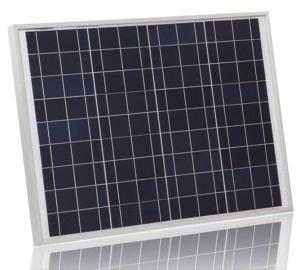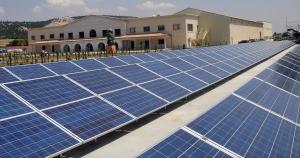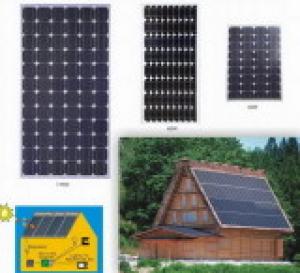Rv Roof Solar Panels - Monocrystalline 195W PV Solar Panel Solar Module
- Loading Port:
- shanghai
- Payment Terms:
- TT or LC
- Min Order Qty:
- -
- Supply Capability:
- 10000000 watt/month
OKorder Service Pledge
OKorder Financial Service
You Might Also Like
Description:
Solar modules use light energy (photons) from the sun to generate electricity through the photovoltaic effect.
The majority of modules use wafer-based crystalline silicon cells or thin-film cells based on cadmium telluride or silicon.
The structural (load carrying) member of a module can either be the top layer or the back layer.
Cells must also be protected from mechanical damage and moisture. Most solar modules are rigid, but semi-flexible ones are available,
based on thin-film cells. These early solar modules were first used in space in 1958.
CNBM Solar photovoltaic (PV) Panel is designed for large electrical power requirements.
It is the optimal choice for both on-grid and off-grid power systems.
CNBM Solar panel offers high performance of power per square foot of solar array.
Monocrystalline silicon(c-Si): often made using the Czochralski process. Single-crystal wafer cells tend to be expensive,
and because they are cut from cylindrical ingots, do not completely cover a square solar cell module without a substantial waste of refined silicon.
Hence most c-Si panels have uncovered gaps at the four corners of the cells.
Characteristics of Solar Monocrystalline
I. Solar Cell : High efficiency crystalline solar cell.
Even if under the weak light, the solar module can produce maximum power output.
II. Tempered glass (toughened glass): Anti-reflecting coating and high transmission rate glass increase
the power output and mechanical strength of solar module.
III. EVA and TPT: Using high quality EVA and TPT to prevent destroying and water.
IV. AI frame: Without screw, corner connection. 6 holes on the frame can be installed easily.
V. Junction box: Multi function junction box with water proof.
VI. Long lifetime: ≥25 years; Less power decrease.
VII. Good performance of preventing from atrocious weather such as wind and hails.
VIII. Resisting moisture and etching effectively, not effected by geology.
IX. The certificate issued by international authority: UL, TUV, IEC, VDE, CE.
vantages of Solar Monocrystalline
• CNBM Solar performance guarantees for 25 years
• 10 years guarantee for workmanship
• Timeliness of delivery
CNBM International Corporation's products including Monocrystalline Solar Panel,
Polycrystalline Solar Panel have received and enjoyed famous reputation in many countries and
regions in the world .As a solar panel manufacturer in China, we strive to provide our customers with excellent service,
superior products and unmatched value.
Specifications:
MONO | 190W | 195W | 200W |
Nominal peak power(Pmax) | 190Wp | 195Wp | 200Wp |
Maximum power voltage(Vmp) | 36.7V | 37.0V | 37.4V |
Maximum power current(Imp) | 5.19A | 5.27A | 5.35A |
Short-circuit current(Isc) | 5.56A | 5.63A | 5.68A |
Open circuit voltage(Voc) | 44.8V | 45.2V | 45.5V |
Optimized cell efficiency(η) | 17.60% | 18.20% | 18.60% |
Power tolerance: ±3% | |||
Limits | |||
Operating temperature | -40°C to +85°C | ||
Maximum system voltage | 1000VDC | ||
Temperature and Coefficients | |||
NOCT | 48°C±2°C | ||
Number of cells and type of connection | 72,serial connection | ||
Dimensions | Length:1580mm | ||
Net weight | 14.80kgs/pc | ||
Gross weight | 450kgs/ctn(28pcs/ctn) 33kgs/ctn(2pcs/ctn) | ||
Package dimension | 1635x1140x956mm 1598x838x88mm | ||
Container loading | 868PCS/40’GP 62PCS/PALLET | ||
STC: Irradiance of 1000W /m2, Air Mass of 1.5, Cell Temperature of 25°C | |||
Guaranteed Power Output | 15 year:90% of its nominal power rating | ||
25 year:80% of its nominal power rating | |||
Impact Resistance | Can bear the force that is generated by one 227g | ||
steel ball fall down from 1m height | |||
Warranty period | 10 years:Materials and workmanship defects | ||
Certificates | CE,ISO,IEC61215&61730(TUV),UL1703/CSA,MCS | ||
Cells | Monocrystalline silicon photovoltaic cell | ||
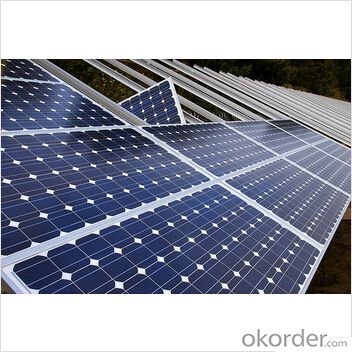
FAQ:
1. How long will my inquiry get response?
Your inquiry related to our products or prices will be replied within 24 hours.
2. Can I get professional service and suggestion?
Well-trained and experienced staffs to answer all your questions in fluent English.
3. Do you accept OEM or customized design?
OEM & ODM, any your customized lightings we can help you to design and put into product.
4. What if I need specific design?
Distributorship are offered for your unique design and some our current models.
- Q: I'm thinking of these solar panels that people have on their rooftops in domestic properties. I suppose I mean after how long do you break even with respect to just carrying on without them and getting you electricity from the utilities companies? Or answer in any way you think is pertinent. The more info the better.
- It's generally stated that it takes 0 years for them to pay for themselves. But the concept of paying for themselves is a primitive concept used by those who do not understand finances. You're still losing money when it pays for itself. A more appropriate analysis would be the Internal Rate of Return calculations, Excel makes this calculation easy. Overall,?solar power?is expensive power and works out about 38 cents per kwh ( proper economic estimates typically place it between 23 cents to 45 cents per kwh ). Some idiot here will insist solar doesn't cost that much per kwh, it does unless you're uneducated in finance. Note, it's also not clear if the energy produced by?solar panels?exceeds the energy required for their manufacture, delivery and installation. It takes a lot of energy to melt silicon and the costs triple if you try to recycle the toxic wastes which is why the panels are made where it's still possible to dispose of the toxic wastes. They could very well be causing more environmental damage then they save. With the Europeans what happens is the feed in tariffs makes the solar panels worthwhile. They still don't really pay for themselves but they allow you to take some of the tax money from your neighbors, a bit of an ethical dilemma really but ethics never stopped Europeans.
- Q: Can solar panels be installed on a metal roof?
- Yes, solar panels can be installed on a metal roof. In fact, metal roofs are often considered ideal for solar panel installation due to their durability and longevity. The metal roof provides a strong and stable surface for mounting the panels, and the sleek design of the panels can complement the aesthetics of the roof. Additionally, the metal roof's reflective surface can help enhance the overall efficiency of the solar panels by bouncing sunlight back onto them.
- Q: Can solar panels be installed on a garage or carport?
- Yes, solar panels can be installed on a garage or carport. These structures often provide ample space and a suitable angle for solar panel installation, allowing homeowners to generate clean and renewable energy while utilizing the available space efficiently. Installing solar panels on a garage or carport can also provide additional benefits such as shade for vehicles, reduced utility bills, and the opportunity to contribute to a greener environment.
- Q: Can solar panels be integrated into windows?
- Yes, solar panels can indeed be integrated into windows. These specialized solar panels are called solar windows or photovoltaic windows. They are designed to function as both windows and solar panels, allowing them to generate electricity while still maintaining their transparency for natural light to pass through.
- Q: How much space is required for solar panel installation?
- The amount of space required for solar panel installation depends on various factors, including the size and number of panels, their efficiency, and the energy needs of the property. On average, a residential solar system typically requires around 100-400 square feet of roof space per kilowatt of installed capacity. However, ground-mounted systems can require larger areas, while more efficient panels may require less space. It is recommended to consult with a solar installer to assess the specific space requirements for your installation.
- Q: My project needs to build a thermal solar panel that would be used as a demonstrational rig. The dimensions i am allowed do not allow me to use a normal thermal solar panel so i have decided to use the heat exchanger from the back of a fridge. Although this is possible to use what equation would i use to prove the power of the sun would actually heat up the water. More importantly when the rig is demonstrated to students, they will need to be able to determine if the raise in temperature given by the thermometers is what should be given. Variables of the rig will include: Angle of the panel, Light intensity, Direction of panel, and more importantly the flow rate of the water travelling through the pipes. What equation includes those variables (change in temperature, flow rate) and would allow me to incorporate the angle of the panel. The light source would be a lamp so i would also need to know how much of the energy from the lamp is actually being used by the panel?
- Forget the long winded discussion above. There are so many variables that you cannot calculate the outcome. This does not mean that the experiment is a failure. It gives you information on the fact that water can be heated in this manner, and that you can vary the result by modifying the variables.
- Q: Just wondering if it is possible to recycle solar panels and where that would be done. If it is possible, is there a money refund in return. Or would it be better to just take the metal off and get a refund in that way? Looking for basically any answer here.
- It looks like you can. Although, I haven't been able to find like a drop off location or anything like that. Here's two phone numbers if you want to ask them. It's Sunday, and I'm assuming they're closed, otherwise I'd just call for you. San Diego (69) 562-783 or Berkeley (50) 843-3. It's a company called Borrego Solar. They look like a BIG solar company that specializes in commercial, residential and public sector turnkey, grid–connected solar electric systems. With over 25 years of experience. They sound like they would know about recycling, and at least be able to give you more information. I think because it's such a specialized item that is being recycled, there aren't going to be many options/drop off locations. Which ever option you choose (disassemble, or recycle as a whole) might depend on if you're looking to save the environment or make a buck. I got some information from the first link below, and the second link is to that Borrego company.
- Q: Hello, i want to ask whether if you could make an improvised version of solar panel made from an old CD or DVD?Is it possible or not?Please give me steps on how to make one if you know(put aside the one you see on quot;ehow: How to Make a Solar Panel From CDswhich says a bit confusing for me :( )Why not?
- Cd Solar Panel
- Q: I was thinking of having some installed on our rooftop and was wondering if it would be worth the cost? The house is located in Sac, Cali. The panels would face the sun 2 months out of the year and in the summer roughly 4 hours of straight sun.
- Solar is too expensive system. It is relatively new. Everything new is top dollar. When the market gets flooded the cost will dramatically go down as everything like cell phones, computers etc.
- Q: I have an off-grid 24volt existing system using 8 x 80 watt 2volt, wired at 24volts, mono solar panels with deep cycle batteries,operating now. I have been given a 240 2volt polly cryst. panel. Can I add this panel to existing panels as above. Thank you, dumb solar man
- Assuming that you have / will upgrade wiring sizes to carry the extra wattage, that the new total wattage resulting from the addition doesn't overload any existing charge controller, diodes and / or inverter you have installed, then paralleling it straight into one of the other 2 volt groups should do nothing but add current to the system. True, it will be somewhat imbalanced, but it will work. Your other options would be to reconfigure everything down to it's native 2 V configuration which will raise current and lower voltage, with the additional panel creating the additional current to raise the wattage or to put it in series with the other 4 panel clusters so that you would get 36 V and additional current to account for the raised wattage. One last approach might be to set it up on another battery bank of it's own (small and at 2 V) to then connect to the same inverter. You'd be getting more power and storage capability that way, sort of a partial backup system, really, that will take some of the load off the other components to help extend their useful lives and get a bit more flexibility into it as well. The choice is yours here. That is all the ways that the system can be connected in, assuming everything in the first sentence checks out;-) It's difficult to make a recommendation without knowing what other components are in use and what the maximum ratings they carry are. Just remember that parallel connections add current and voltage stays the same, series connections add voltage and the current remains the same and you can figure out what to do with this thing to help you if you stay within maximum ratings for the charge controller, diodes and / or inverter involved. Good luck and stay safe!
Send your message to us
Rv Roof Solar Panels - Monocrystalline 195W PV Solar Panel Solar Module
- Loading Port:
- shanghai
- Payment Terms:
- TT or LC
- Min Order Qty:
- -
- Supply Capability:
- 10000000 watt/month
OKorder Service Pledge
OKorder Financial Service
Similar products
Hot products
Hot Searches
Related keywords
